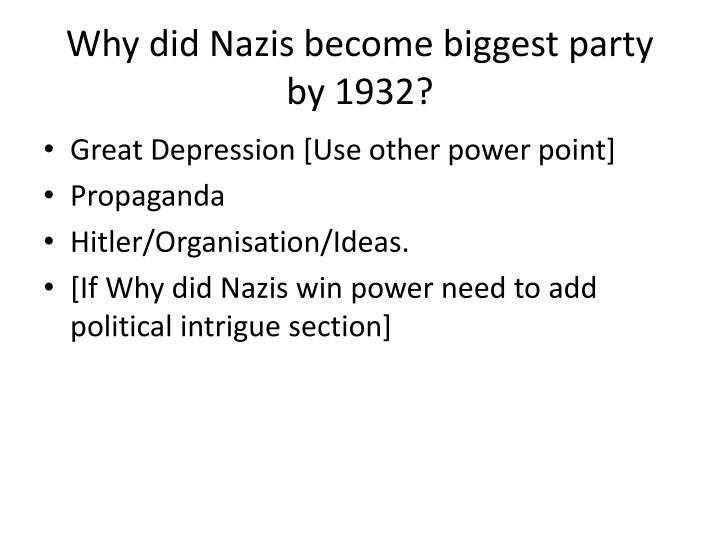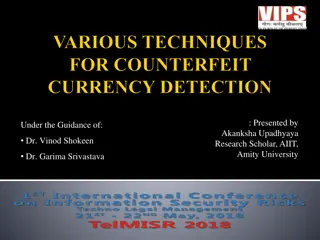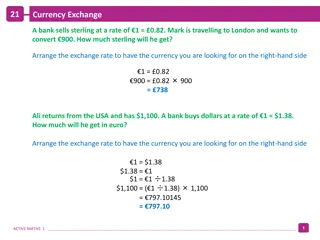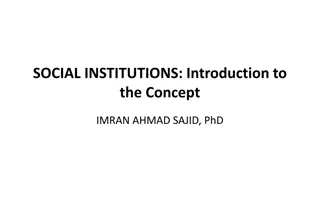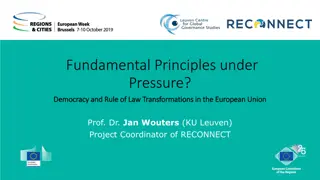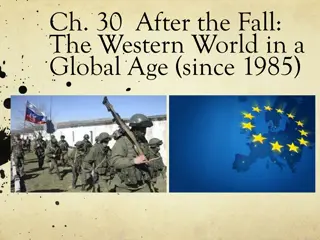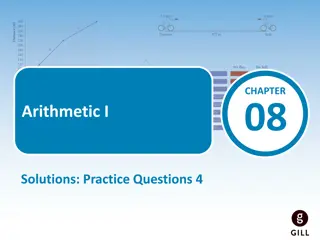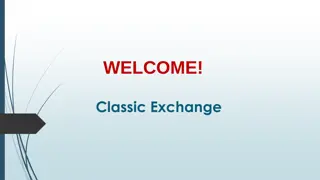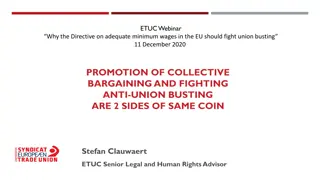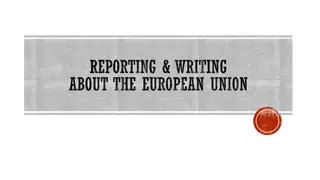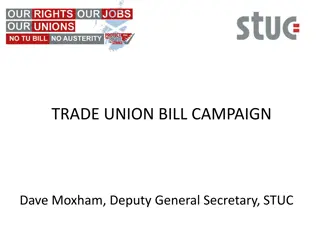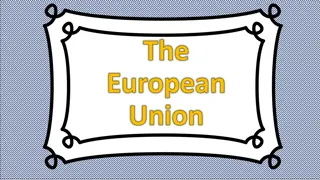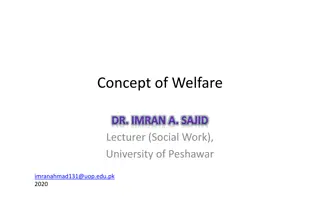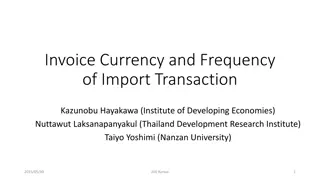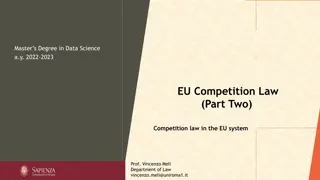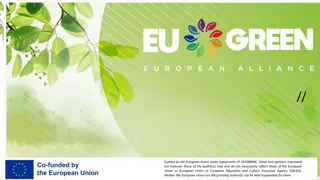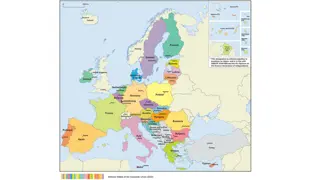European Union: History, Institutions, Principles, Currency
The European Union, established on 9th May 1950 as the European Economic Community and later evolved into the European Union in 1993, consists of 27 member states with diverse official languages. Key institutions include the European Parliament, the Council of the EU, and the European Commission, responsible for legislative, executive, and oversight functions. The EU operates on principles of currency unity, freedom of movement, education, peacekeeping, security, law, job opportunities, and environmental care. The Euro became the single currency in 2002, facilitating economic integration across member countries.
Download Presentation

Please find below an Image/Link to download the presentation.
The content on the website is provided AS IS for your information and personal use only. It may not be sold, licensed, or shared on other websites without obtaining consent from the author.If you encounter any issues during the download, it is possible that the publisher has removed the file from their server.
You are allowed to download the files provided on this website for personal or commercial use, subject to the condition that they are used lawfully. All files are the property of their respective owners.
The content on the website is provided AS IS for your information and personal use only. It may not be sold, licensed, or shared on other websites without obtaining consent from the author.
E N D
Presentation Transcript
Why did Nazis become biggest party by 1932? Great Depression [Use other power point] Propaganda Hitler/Organisation/Ideas. [If Why did Nazis win power need to add political intrigue section]
Propaganda The Nazis had a highly centralised propaganda machine under the direction of Josef Goebbels who was himself a superb propagandist. Close attention was paid to local propaganda. Key individuals in local communities were targeted and won over, the idea being that these influential local people would then go out and spread the word. Nazi organisations for youth, for women, for workers were also used as vehicles for propaganda. Perhaps most important, the entire SA, for all their violence and thuggery, were also deployed in the propaganda campaigns. They projected an image of strength, order and youthful dynamism, and of tough anti-communism, and at the same time assisted at soup kitchens and other welfare projects run by the Nazis. Propaganda by deed.
Propaganda Propaganda was crucial and in particular the projection of the image of Adolf Hitler as the strong man the country needed proved to be highly successful. Hitler s speeches were also propaganda and he used these very effectively to target Germans specific grievances and tailored his message to whichever audience he was addressing. Other Nazi speakers were effective too. They were always trained speakers (over 6 000 by 1933). Rallies, torchlight parades, leaflets and posters were also used to get the message out. The swastika banner was effective in giving the Nazis a clear, striking visual symbol that everyone recognised.
Propaganda Technology was used effectively to create the image of Hitler as the man of the hour especially during the 1932 presidential election campaign when Hitler was flown around by plane so that he could reach lots of places quickly but also to convey the idea of him as a messianic figure descending to earth from heaven. Role of and use of the press and media: relationship with Hugenberg and the DNVP Frank McDonough: A key factor that greatly contributed to the Nazis rise to power was effective propaganda. Nazi propaganda was centrally controlled and organised by Josef Goebbels. It is no coincidence that the great surge in Nazi electoral support took place in the period after Goebbels took control of Nazi Party propaganda.
Propaganda Jill Stephenson: Nazi propaganda was a powerful weapon, particularly when it was deployed utterly unscrupulously, with mutually irreconcilable promises made to different social or regional groups at the same time but in different locations. But what enabled the NSDAP to disseminate its propaganda was the growing strength of its organisation. Propaganda mobilised those already inclined to support the Nazis more than it affected those who were committed politically to another party.
Propaganda Secret report of Reich Propaganda Leadership [Nazi] Nov 1932 We are of the opinion that little can be salvaged by way of propaganda New paths must be taken Noakes suggests that propaganda is over stressed as a reason for Nazi success. Lots of propaganda in areas where Nazis do badly and often little in areas they do well.
Hitler Organisation Ideas Hitler s leadership as distinct from his propaganda image was crucial. He provided charismatic leadership. He was indeed an excellent orator who was especially good at identifying his audiences emotions and expectations, and aligning himself with them. His insistence on the Fuhrerprinzip meant that his authority could not be challenged. Nazi party organisation was also important. The party was organised into a series of Gaue (Districts/regions) each headed up by a Gauleiter. Nazi organisations were set up for lots of different groups in society from youth to lawyers to factory workers and agricultural workers.
Hitler Organisation Ideas The Nazi party were highly effective as a campaigning organisation with a powerful message. The Nazis were also helped by the economic collapse of 1929-32. The Nazis were helped too by hatred of the Treaty of Versailles. The Nazis were helped by the fact that the Weimar Republic seemed to be completely incapable of keeping Germany free of economic and political crises.
Hitler Organisation Ideas Although the Nazi Party was close to bankruptcy by November 1932, Hitler had the backing of some leading industrialists including Fritz Thyssen. Thyssen along with Bosch, Krupp and Hjalmar Schacht petitioned the President to appoint Hitler as Chancellor. This gave Hindenburg the impression of a far wider base of support among businessmen than Hitler actually had.
Hitler Organisation Ideas Richard J Evans: By 1932 the Nazis were a catch all party of social protest with particularly strong middle class support and relatively weak working class backing at the polls. The Nazis successfully projected an image of dynamism and salvation of the national community. Ian Kershaw: The NSDAP came to function increasingly as a super-interest party. In thus projecting himself and the Nazi movement, Hitler tapped into the burgeoning national mood far more effectively than his rivals.
